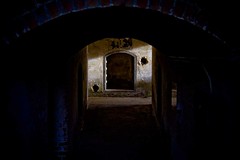The Micro Four Thirds camera system has taken the photographic world by storm becoming 3rd in sales of dSLR-like cameras in Japan behind Canon and Nikon dSLRs.
There are a number of reasons for their popularity which essentially results from a culmination of various technologies coming together to make such a system possible in a functional manner for the first time.
Point and shoot users who are tired of the poor image quality, lack of versatility and limited ability to progress with learning photography have discovered that Micro Four Thirds can address all these issues and still be relatively compact and light, although still not cheap.
DSLR users have adopted Micro Four Thirds in their droves because it offers a much smaller and lighter, less intimidating camera kit to take almost anywhere and which compliments their dSLR kits beautifully, while only giving up marginal image quality.
Leica M rangefinder wannabe’s have also flocked to Micro Four Thirds, because for the first time they can get relatively affordable access to a Leica-like system with the ability to use almost any 35mm rangefinder lens, and unlike the far more expensive Leica M9, you get fast live preview manual focus and video as well as an option for autofocus lenses.
Creative photographers will also enjoy the fact that almost any 35mm lens ever made can be used and in addition, now be converted into a tilt lens via the new tilt adapter mentioned in a previous post.
Street photographers and candid portrait photographers just love the Panasonic 20mm f/1.7 M43 lens.
Whilst a Micro Four Thirds camera and lenses may solve 90% of photographic needs, the system is still immature and is not able to and may not ever be able to solve all photographic needs.
Let’s look at the many pros of the Micro Four Thirds system:
Large sensor in comparison to point and shoot cameras:
- much better image quality, especially at higher ISO – very usable at ISO 800-1600, although marginally not as good as cropped sensor dSLRs or full frame dSLRs, but these mandate much larger lenses.
- much shallower depth of field and thus ability to make your subject pop if using a wide aperture lens such as the 20mm f/1.7 pancake lens or a 50mm f/2.0 lens (M43 version coming next year), or the many legacy 35mm lenses – you can even use a Canon EF 135mm f/2.0L lens wide open with fantastic results, or a Voigtlander 50mm f/1.1 Leica M rangefinder lens.
- much better low light performance – higher ISO perfromance, image stabilisation, large aperture lenses.
2x crop factor sensor:
- generally allows better edge-to-edge image quality, particularly when used with telecentric Four Thirds and Micro Four Thirds lenses
- fantastic super telephoto reach in a compact hand holdable package (although Olympus dSLRs would be even better for this)
- many sports events wont allow more than 200mm focal length lenses, a 2x crop camera will give you much more telephoto reach.
- increased depth of field in comparison to full frame cameras may be valuable for macro work as well as landscape work, while for low light portraiture, it means you could use a 50mm f/1.4 lens at lower ISO, but still have sufficient DOF to capture your subject – sometimes very shallow DOF of full frame dSLRs is NOT in your favour.
- smaller image circle means smaller lenses needed.
Short lens flange to sensor distance:
- allows almost any legacy lens to be adapted including rangefinder lenses, and allows tilt adapter to be used on 35mm SLR lenses.
- allows far more compact super wide angle lenses – compare the Micro Four Thirds 7-14mm zoom with the Four Thirds 7-14mm zoom
- allows more compact camera/pancake lens kits
No mirror and no prism:
- allows the most efficient and accurate manual focus system available, and brilliant for MF of tilt-shift lenses which require magnified live view for accurate focus.
- quieter shutter – hopefully in the near future, fully silent mode will be possible with electronic shutter for still images
- no mirror vibrations to blur the photos, and thus no need to set a mirror lockup for super telephotos or macro work
- means less moving parts to go wrong, and importantly, as the system matures, it should become much cheaper to roll out new bodies with upgraded sensors and features as there is no phase detect AF system, no mirror, and no prism to pay for, or to constrain the design of the body. This will become very important, we all hate having cameras that become technologically obsolete within 3-5 years, now there is an opportunity for bodies to be replaced quite cheaply so you are more able to stay with the advances. Furthermore, the cost will be able to be reduced due to the economies of scale that such a popular system will provide. A win-win situation.
Electronic viewfinder:
- the new EVFs are so good that the view is better than in some entry level dSLR optical viewfinders and this will only get better as technology improves
- allows real time display of digital filter effects, shutter speed effect, exposure effect, live histogram, camera level indicators (on Olympus), image aspect ratio, grid lines, etc.
- allows option of tiltable or potentially in the future, removable EVF
- much better view in low light or with stopped down legacy lenses than on optical dSLRs
Fast contrast detect autofocus:
- no back focus AF calibration errors that need to be corrected as with dSLRs
- fast enough to maintain AF on a subject as you walk towards it taking 3.5fps shots (using GH-1 with 14-140mm lens in AFC mode)
- fast face recognition comes in handy
- ability to track a selected object which is actually very handy – just choose your subject in tracking mode, and even if you zoom in or out, or get closer to subject, it will regain focus although this mode gives you blurry shots every alternate shot in 3.5fps burst mode as you walk towards a subject, as it takes a touch longer to recognise the subject that just AF on a given point. This is fast enough to track walking people, moving cars (using GH-1 with 14-140mm lens in AFC mode)
- the best AF system for macrophotography currently available (with Pan. 45mm f/2.8 macro lens)
Optimised for HD video:
- extra lens contacts means faster contrast detect AF which is essential for HD video AF
- 14-140mm HD lens is the only dSLR-like lens optimised for HD video
- the only dSLR-like camera that will allow continuous AF in HD videos (Pan. GH-1 with 14-140mm HD lens)
Now, let’s look at some of the cons:
Too small:
- some people with big hands will find such cameras too small to handle well
- large, heavy lenses become unweildy – if you want to use a Olympus ZD 50-200mm f/2.8-3.5 lens, then an Olympus dSLR may be a better option on handling alone let alone this lens will not AF on a Micro Four Thirds yet.
- sometimes a large camera is needed to give you credibility
Autofocus not fast enough yet:
- as fast as the AF is, especially on the Panasonic models, it is only as fast as entry level dSLRs and will not yet match pro dSLRs, and thus shooting sports and action may not be as easy using AF.
- having said that GH-1 +14-140mm lens at 90mm gives more in-focus images walking towards a subject and shooting at 3.5fps than does my Canon 1D mark III with 135mm f/2.0L lens at 3fps but then AF on that model has been buggy from the start 🙁
- at the current rate of technology change, I would think it would not be long before contrast detect AF becomes faster than dSLR phase detect technology which struggles with different temperatures, etc as it is not actually using the final image to judge focus accuracy. Olympus was right not to pursue their revolutionary E330 dSLR’s dual AF system – I think contrast detect AF will win in the end.
Still noisy at higher ISO:
- if you really need to use ISO > 1600, then you need to look at a full frame dSLR, but remember, you can usually get more telephoto reach at faster aperture on this system than on a full frame dSLR which may allow you to use a lower ISO than on a dSLR.
- dynamic range will always be marginally less than on full frame dSLRs of similar technology.
Limited flash systems:
- no remote TTL flash capability as yet let alone radio wireless TTL flash
- no inbuilt flash on some models
- needs a compact macrophotography flash system although can use Olympus SR-11 Ring flash, etc as well as Canon Ring Flash (in manual mode)
- flash sync 1/160th or 1/180th sec although high sync flash is available (FP flash) if use a FP-capable flash such as Olympus FL-50R
Limited range of AF lenses:
- only one lens will do continuous AF in HD video – but then no other dSLR can do this
- limited wide aperture prime lenses – need 12mm f/2.0, 40mm f/1.4, 50mm f/2.0 macro, 100mm f/2.0 macro, 200mm f/2.8, 250mm f/4 – at present we have 17mm f/2.8, 20mm f/1.7, 25mm f/1.4 Leica-D Four Thirds, 50mm f/2.0 macro Four Thirds (but slow if any AF on M43).
No shift lenses:
- you can get a tilt adapter to convert almost any 35mm legacy lens into a tilt lens but no shift capability
- can use legacy or even Canon EF shift lenses, but no dedicated M43 shift lenses
No through-the-lens optical viewfinder:
- you can’t have your cake and eat it – no mirror, no through-the-lens optical view
- a good dSLR will have minimal blackout of your view during burst shooting, even at 10fps – the GH-1 even at 3.5fps has some very noticeable blackout between frames – but technology should improve this for future cameras, and you could opt for a hot-shoe mounted optical viewfinder instead.
- the view through a high quality full frame optical viewfinder can in itself be inspiring and nurture your creativity – something that is not easy to replicate with an EVF – yet, but it will happen
Most Micro Four Thirds lenses need digital correction of aberrations:
- with the ready availability of post-processing or even in-camera aberration correction, the M43 lenses generally are designed to allow more aberrations so they can be designed more compact – a reasonable compromise but it may mean some loss of edge sharpness.
Video mode limitations:
- 17mbps compression rate a touch too aggressive – 25mbps would be better
- no B-frames in AVCHD compression means motion is not recorded as well as it could be
- needs more frame rate options for the video enthusiasts
- no power zoom – but then no dSLR is likely to get this either
- no control over audio level
Special functions not yet available:
- no intervalometer
- no wireless remote camera control
- no live view output to external devices
- burst rate is only 3.5fps – similar to most entry level dSLRs but not up there with 5-10fps of the pro dSLRs
- no GPS tagging – but this will come when the new GPS chips which do not use up as much battery life get to market
- limited third party software control – an issue for astrophotographers
- 20+ megapixels is not going to happen in the near future and if you really need this resolution and image stitching is not suitable, consider a medium format digital or film camera.
Personally, the Micro Four Thirds will replace my Canon EF 24-105mm f/4L IS lens for most of my photography, but I will still use my Olympus dSLR with ZD 50-200mm f/2.8-3.5 SWD lens (just love this combination, while others will also love the ZD 35-100mm f/2.0 lens), and my Canon 1D Mark III with tilt-shift lenses and the 135mm f/2.0L lens.
The Micro Four Thirds kit will do almost everything else well enough to produce good 20″x30″ prints and I don’t need any bigger.
Which would you rather take to the zoo with you:

This photo was posted on dpreview.com forum today by Robert Deutsch and compares Canon 5D full frame with Canon 100-400mm IS L lens and a Panasonic GF-1 M43 camera with Panasonic 45-200mm lens.
He also posts comparison images hand held with each at 400mm effective focal length, ISO 200 and there is little difference in image quality – so which would you take?
Personally, I would take my Olympus E510 + ZD 50-200mm lens to the zoo – the 400mm f/3.5 with IS gives a nice compromise with better background blurring for portraits such as when used at 100mm f/2.8, while allowing close focus to 1.2m, as well as my GH-1 with 14-140mm for video and snapshots.











To answer your question, I would gladly take the 5D Mark II with the 100-400mm IS L (I have this setup) over the Panasonic kit. I could maybe see myself having a micro 4/3 as my “I don’t care as much if something happens to it” camera, but it could never replace my full frame dslr. I could never see myself photographing a wedding or senior photos using a micro 4/3 system. I would feel and probably look like a dumb@ss holding this little camera trying to take photos. Just because I’m not a big fan of these smaller cameras doesn’t mean that everyone is going to feel the same way. I have always felt that you should shoot with what feels comfortable and since I shoot architecture/landscapes and sports/racing, I feel most comfortable with my 5D Mk2 and 1D Mk3. For someone who is taking pictures of their kids or likes to travel light, a micro 4/3 seems ideal for that type of person.